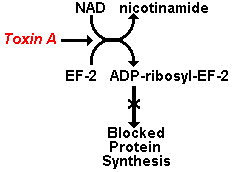|
Pseudomonas
ORGANISM:
- Genus: Pseudomonas
- Species: aeruginosa, others
GENERAL CONCEPTS:
- Greater than 140 species of Pseudomonas have been described and most are saprophytic.
- In terms of human disease, Pseudomonas is generally an opportunistic pathogen. However, the genus is responsible for several specific diseases including glanders (P. mallei) and melioidosis (P. pseudomallei).
- Pseudomonas infections may be serious in hospitalized patients or those with cancer or cystic fibrosis.
DISTINCTIVE PROPERTIES:
- Pseudomonads are Gram negative rods. They are motile, nonfermentative aerobes that can utilize acetate for carbon and ammonium sulphate for nitrogen. Many species are resistant to high salt, dyes, weak antiseptics and most antibiotics. P. aeruginosa can grow at 42°.

- Pseudomonas possesses the LPS endotoxin characteristic of other Gram-negative bacteria and displays O and H antigens.
- Pseudomonas produces many exoenzymes including hemolysins, leukocidins and proteases. In addition, a toxin called Toxin A is the most toxic product produced by Pseudomonas. This product causes the ADP-ribosylation of translation factor EF-2, producing ADP-ribosyl-EF-2. The effect of this enzymatic activity is the loss of host cell protein synthesis capability. This mechanism is identical to that produced by diphtheria toxin.
- Also, a protein called exoenzyme S is another ADP-ribosyltransferase, transferring the ADP-ribose from NAD to other proteins (not EF-2).
- Pseudomonas has an antiphagocytic polysaccharide slime layer and many strains produce pigments, some which are fluorescent.
PATHOGENESIS:
- Pseudomonas produces localized infections following
surgery or burns. Localized infections can lead to generalized, and occasionally fatal, bacteremia.
- Pseudomonas is also responsible for a number of nosocomial infections including urinary tract infections following catheterization, pneumonia resulting from contaminated respirators, and eye and ear infections.
HOST DEFENSES:
- Most Pseudomonas species are complement-resistent; the best host defense seems to be opsonization and PMN phagocytosis.
- Once an infection becomes established, however, antitoxin (a humoral response) is very important.
EPIDEMIOLOGY:
- Pseudomonas can be found in the soil, in water, or on vegetation.
- On average, 3% of persons entering the hospital have Pseudomonas in their stool. After a hospital stay of as little as 72 hrs, 20% have Pseudomonas. The organisms are spread from patient to patient via staff, contaminated reservoirs, respiratory equipment, food, sinks, taps, mops; most moist environments.
DIAGNOSIS:
- Clinical: Diagnosis is very difficult.
- Laboratory: Pseudomonas can be easily isolated on blood agar. These organisms are non-fermentative (oxidative), oxidase-positive, Gram-negative bacilli. They often give off a fruity odor and some may produce fluorescent pigments. P. aeruginosa grows well at 42°.
CONTROL:
- Sanitary: Several sanitary measures are important in the prevention of Pseudomonas infections. Proper isolation and topical therapy of burn patients, good aseptic technique and the careful cleaning and sterilization of instruments are important.
- Immunological: None currently available.
- Chemotherapeutic: Gentamycin, tobramycin or a gentamycin/carbenicillin combination are the drugs of choice for treating serious Pseudomonas infections.
|
|